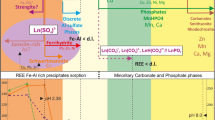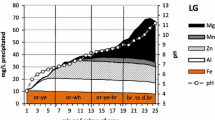Abstract
Buffering mechanisms of acidic mining lakes were studied on an acidic open cast lignite mining lake (Plessa 111) in Lusatia, eastern Germany. The investigations were based upon laboratory experiments, hydrochemical modelling and mineralogical structure determination. The experiments were carried out as titrations of the lake water. The modelling was done using the hydrogeochemical simulator PHREEQC. Three different phase models were applied:(1) an iron- and aluminium hydroxide precipitation model, (2) an iron- and aluminium hydroxysulphate precipitation model and (3) an iron hydroxide and aluminium hydroxysulphate precipitation model with sorption on iron hydroxide. As a result of this study four different buffers in four successive sections of the titration curve could be detected in acidic mining lake water:(1) hydrogen sulphate buffering, (2) iron buffering, (3) aluminium buffering and (4) an additional buffering (solid phase buffer) which is based on ion exchange and mineral transformation. Mineralogical analysis showed that iron precipitates as schwertmannite, an iron hydroxysulphate. Aluminium precipitates are also hydroxysulphates. These results allow formulation of process-oriented description of the buffering processes in acidic mine waters. This could lead to better reliability in lake water quality and pH-development predictions of acidic mining lakes.
Similar content being viewed by others
References
Bigham J.M., Schwertmann U., Carlson L.and Murad E.(1990)A poorly crystallized oxyhydroxy sulfate of iron formed by bacterial oxidation of Fe(II)in acid mine waters. Geochim.Cosmochim.Acta 54, 2743–2758.
Bigham J.M., Carlson L.and Murad E.(1994)Schwertmannite,a new iron oxyhydroxy-sulphate from Pyha ¨salmi,Finland,and other localities.Mineral.Mag.58, 641–648.
Bigham J.M., Schwertmann U.and Pfab G.(1996a)In. uence of pH on mineral speciation in a bioreactor simulating acid mine drainage.Appl.Geochem.11, 845–849.
Bigham J.M., Schwertmann U., Traina S.J., Winland R.L.and Wolf M.(1996b)Schw-ertmannite and the chemical modeling of iron in acid sulfate waters.Geochim.Cosmochim. Acta 60, 2111–2121.
Bozau E.and Strauch G.(2002)Hydrogeological basis for biotechnological remediation of the acidic mining lake “RL111”,Lusatia.Water Air Soil Poll.Focus 2, 15–25.
Dzombak D.A.and Morel F.M.M.(1990)Surface complexation modelling-hydrous ferric oxide. John Wiley and Sons, New York.
Furrer G., Phillips B.L., Ulrich K.U., Po ¨thig R.and Casey W.H.(2002)The origin of aluminum. ocs in polluted streams.Science 297, 2245–2247.
Fyson A.and Kalin M.(2000)Acidity titration curves –a versatile tool for the character-ization of acidic mine waste water.In UFZ-Bericht (eds.K.Friese,et al.),Vol.6 pp.21–24. Centre for Environmental Research, Leipzig,Germany.
Geller W.(in press)Acidi cation of fresh waters.In Encyclopedia of Water (ed.J.H. Lehr). John Wiley and Sons, New York.
Geller W.and Schultze M.(1999)Tagebauseen der Braunkohlengebiete.Schr.-R.d.Deuts-chen Rates fu ¨r Landesp. ege 70, 129–134.
Geller W. Klapper H.and Schultze M.(1998)Natural and anthropogenic sulfuric acidi cation of lakes.In Acidic Mining Lakes (eds.W.Geller, H.Klapper and W.Salomons),pp.3–14. Springer, Berlin.
Geller W., Friese K., Herzsprung P., Kringel R.and Schultze M.(2000)Limnology of sul-phur-acidic lignite mining lakes.II.Chemical main constituents and bu. ering systems. Verh.Internat.Verein. Limnol.27, 2475–2479.
Go ¨ttlicher J., Gasharova B.and Pohlmann M.(2003)Mineralreaktionen in Braunkohlent-agebaukippen:Ihre Bedeutung fu ¨r die Versauerung von Grund-und Ober. a ¨chenwa ¨ssern am Beispiel des ehemaligen Tagebaus Plessa (Lausitz).In Geowissenschaften und Umwelt – Handlungsoptionen fu ¨r eine nachhaltige Raumentwicklung (eds.S.Kohne,and P.Wycisk), pp.19–31.Martin-Luther-University, Halle,Germany.
Klapper H.and Schultze M.(1995)Geogenically acidi ed mining lakes –living conditions and possibilities of restoration.Int.Rev.ges.Hydrobiol.80, 639–653.
Klapper H., Boehrer B., Packro. G., Schultze M., Tittel J.and Wendt-Pottho. K.(2001) Bergbaufolgegewa ¨sser –Limnologie –Wassergu ¨tebewirtschaftung.In Handbuch Ange-wandte Limnologie (eds.C.E.W. Steinberg, H.Bernhadt and H.Klapper),pp.3–64. Ecomed,Landsberg am Lech.
Knoll D., Weber L.and Scheider W.A.(1999)Grundwasseranbindung von alten Tagebau-restseen im niederlausitzer Braunkohlentagebaugebiet.Grundwasser –Zeitschrift der Fachsektion Hydrogeologie 2, 55–61.
Nixdorf B., Lessmann D.and Steinberg C.E.W.(2003)The importance of chemical bu. ering for pelagic and benthic colonization in acidic waters.Water Air Soil Poll.Focus 3, 27–46.
Parkhurst D.L.and Apello C.A.J.(1999)User 's guide to PHREEQC (Version 2)–A computer program for speciation,batch-reaction,one dimensional transport,and inverse geochemical calculations.Water-Resources Investigations Report 4259,US Department of the Interior, Denver,Colorado,312 pp.
Peine A., Tritschler A., Ku¨sel K.and Peiffer S.(2000)Electron. ow in an iron-rich acidic sediment –evidence for an acidity-driven iron cycle.Limnol.Ozeanogr.45, 1077–1087.
Sche. er F.and Schachtschabel P.(1989)Lehrbuch der Bodenkunde. Enke,Stuttgart.
Schwertmann U., Su¨sser P.and Na ¨tscher L.(1987)Protonenpu. ersubstanzen in Bo ¨den.Z. P. anzenern.Bodenk.150,174–178.
Totsche O., Fyson A.and Steinberg C.E.W.(2002)Chemical and microbial neutralization of acidic mining lakes –bu. ering of extreme acidic mining lakes.In Proc.Third International Conference on Water Resources and Environmental Research, pp.170–173,Dresden,Ger-many,July 22 –25 2002,Technical University, Dresden.
Uhlmann W., Nitsche C., Neumann V., Guderitz I., Leßmann D., Nixdorf B.and Hemm M. (2001)Tagebauseen:Wasserbescha. enheit und Wassergu ¨tebewirtschaftung –Konzeptionelle Vorstellungen und erste Erfahrungen.Studien und Tagungsberichte 35,Landesumweltamt Brandenburg, Potsdam,77 pp.
Uhlmann W., B ü uttcher H., Totsche O.and Steinberg C.E.W.(2004)Bu. ering of acidic mine lakes:the relevance of surface exchange and solid-bound sulphate.Mine wat.envir.23, 20–27.
Ulrich B.(1981)O ¨kologische Gruppierung von Bo ¨den nach ihrem chemischen Bodenzustand. Z.P. anzenern.Bodenk.144, 289–305.
Ulrich B.(1985)Natu ¨rliche und anthropogene Komponenten der Bodenversauerung.Mit-teilgn.Dtsch.bodenkundl.Gesellsch.43, 159–187.
Ulrich K.U.and Po ¨thig R.(2000)Pra ¨zipitation von Aluminium und Phosphat in Gewa ¨ssern unter dem Ein. uss von Versauerung.Acta hydrochim.hydrobiol.28, 313–322.
Author information
Authors and Affiliations
Rights and permissions
About this article
Cite this article
Totsche, O., Pöthig, R., Uhlmann, W. et al. Buffering Mechanisms in Acidic Mining Lakes – A Model-Based Analysis. Aquatic Geochemistry 9, 343–359 (2003). https://doi.org/10.1023/B:AQUA.0000029035.88090.eb
Issue Date:
DOI: https://doi.org/10.1023/B:AQUA.0000029035.88090.eb




